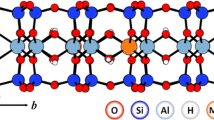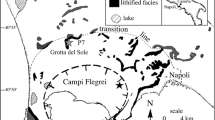Abstract
A series of Cu(II) reduced charge montmorillonites (RCM) of varying charge reduction has been prepared by exchange of the parent Li(I)-Na(I) mineral with CuCl2 in 95 per cent ethanol solution. The Cu(II) exchange capacity, as determined by Na(I) exchange in 1:1 (v/v) ethanol-water, is a linear function of the fraction of Li(I) initially present on the exchange sites, F. Selective Cu(II)-saturation on internal and external sites was achieved at maximum charge reduction (F = 1.0). Water sorption isotherms and (001) basal spacings are interpreted in terms of an increasing tendency toward interlayer collapse with increasing charge reduction. Because of the higher hydration energy of the Cu(II) ion, however, the fraction of non-expansible interlayers at a given F value is lower than those present in the corresponding Li(I)-Na(I) RCM. Electron spin resonance spectra of oriented samples show that under air-dried conditions (ca. 40 per cent r.h.) the predominant Cu(II) species present, whether on internal or external sites, is the planar Cu(H2O)2+4 ion. The symmetry axis of the ion is oriented perpendicular to the a-b plane of the silicate sheets. In the presence of a full partial pressure of water, the Cu(II) ions on the external sites and those which are in expansible interlayers become totally hydrated Cu(H2O)2+6 and tumble rapidly. The Cu(H2O)2+4 ions in non-expansible layers retain their restricted orientation on the silicate surface. Some general conclusions have been drawn regarding the nature of charge distribution in the mineral.
Résumé
Une série de montmorillonites Cu(II) à charge réduite dans des proportions variables (RCM) a été préparée par échange du minéral initial Li(I)-Na(I) avec CuCl2 en solution éthanol à 95 pour cent. La capacité d’échange Cu(II) déterminée par l’échange de Na(I) dans des solutions éthanol-eau 1:1 (v/v), est une fonction linéaire de la fraction de Li(I) initialement présent sur les sites d’échange, F. La saturation sélective en Cu(II) des sites internes et externes est obtenue par une réduction maximale de la charge (F = 1,0). Les isothermes d’adsorption d’eau et les espacements basais (001) sont interprétés en termes d’une tendance croissante à la fermeture des espaces interfeuillets avec une réduction de charge croissante. Cependant, à cause de l’énergie d’hydratation plus élevée de l’ion Cu(II), la fraction d’espaces interfeuillets non expansibles à une valeur donnée de F est plus basse que celle que l’on trouve dans la RCM Li(I)-Na(I) correspondante. Les spectres de résonance de spin électronique d’échantillons orientés montrent qu’en conditions air-dry (40 pour cent d’humidité relative), l’espèce Cu(II) prédominante aussi bien sur les sites internes que sur les sites externes, est l’ion plan Cu(H2O)2+4.
L’axe de symétrie de l’ion est orienté perpendiculairement au plan ab des feuillets. En présence d’une pression partielle de vapeur d’eau saturante, les ions Cu(II) des sites externes et ceux qui sont dans les espaces interfeuillets expansibles s’hydratent totalement en ions Cu(H2O)2+6 et prennent rapidement une orientation quelconque. Les ions Cu(H2O)2+4 dans les espaces non expansibles gardent leur orientation privilégiée par rapport à la surface. Des conclusions générales sont tirées à propos de la nature de la distribution de la charge dans le minéral.
Kurzreferat
Aus einem ursprünglich Li(I)-Na(I)-belegten Mineral wurde durch Austausch mit CuCl2 in 95 Prozentsatz iger Äthanollösung eine Reihe von Cu(II)-belegten Montmorilloniten verminderter Ladung (RCM) mit unterschiedlicher Ladungsabnahme hergestellt. Die Cu(II)-Austauschkapazität, bestimmt durch Na(I) in einem Äthanol-Wasser-Gemisch im Volumenverhältnis 1:1, ist eine lineare Funktion des ursprünglich an den Austauschplätzen vorliegenden Li(I), F. Selektive Cu(II)-Sättigung an inneren und äußeren Austauschplätzen wurde bei maximaler Ladungsverminderung (F = 1,0) erreicht. Die Wasseradsorptionsisothermen und (001)-Basisebenenabstände wurden als Ergebnis einer mit zunehmender Ladungsverminderung steigenden Neigung zur Zwischenschichtkontraktion gedeutet.
Wegen der höheren Hydratationsenergie des Cu(II)-Ions ist jedoch der Anteil der nichtaufweitbaren Zwischenschichten bei gegebenem F-Wert niedriger als der Anteil in den entsprechenden Li(I)- und Na(I)-belegten RCM.
Elektronenspinresonanzspektren orientierter Proben zeigen, daß unter lufttrockenen Bedingungen (ca. 40 Prozentsatz relative Feuchte) sowohl an den inneren als auch an den äußeren Austauschplätzen das planare Cu(H2O)2+4-Ion die vorherrschende Zustandsform des Cu(II) darstellt. Die Symmetrieachse des Ions ist senkrecht zur a-b-Ebene der Silicatschichten angeordnet. Bei Vorliegen eines vollen Wasserpartialdruckes werden Cu(II)-Ionen an den äußeren Oberflächen und an den aufweitbaren Zwischenschichten zu vollständig hydratisierten Cu(H2O)2+6 -Ionen und gehen schnell in einen ungeordneten Zustand über. Die Cu(H2O)2+4-Ionen in den nichtaufweitbaren Schichten behalten ihre eingeschränkte Orientierung an den Silicatoberflächen. Einige allgemeine Schlußfolgerungen bezüglich der Art der Ladungsverteilung im Mineral werden gezogen.
Резюме
Ряд Си(II) монтмориллонитов с уменьшенным зарядом (КСМ) до различных степеней приготовляется путем обмена маточного минерала Li(I)-Na(I) с СuСl2 в 95 % растворе этанола. Способность обмена Си(II), определяемая обменом Nа(I) в 1: 1 (процентное соотно-шение объемов) этанола-воды, является линейной функцией фракции Li(I) первоначально присутствующей на позициях обмена, Р. Селективное насыщение Cu(II) на внутренних и наружных позициях получается путем максимального понижения заряда (F = 1,0). Изотермы адсорбции воды и основные позиции (001) истолковываются повышающейся тенденцией к разрушению прослойки при возрастающем уменьшении заряда. Однако вследствие более высокой энергии гидратации иона Си(П), фракция нерасширяющихся промежуточных слоев при определенной величине F ниже, чем присутствующая в соответствующем Li(I)-Na(I) RСМ. Резонансный спектр электронного спина ориентированных образцов показывает, что в воздушно-сухих условиях (около 40% относительной влажности) объектом Си(П), присут-ствующим главным образом на внутренних или наружных позициях, является плоский ион Сu(Н2O)42+. Ось симметрии иона находится перпендикулярно к плоскости а-Ь силикатных листов. В присутствии полного частичного давления воды, ионы Си(П) на наружных позициях и те которые находятся на расширяющихся промежуточных слоях становятся полностью гидратированным (Сu(Н2O)62+ и быстро падают. Ионы Сu(Н2O)42+ на нерасширяющихся слоях сохраняют свою строгую ориентацию на поверхности силиката. Пришли к общим заключениям о характеристике распределения заряда в минерале.
Similar content being viewed by others
References
Adrian, F. J. (1968) Guidelines for interpreting ESR spectra of paramagnetic species adsorbed on surfaces: J. Colloid Interface Sci. 26, 317–354.
Angel, B. R. and Hall, P. L. (1972) Electron spin resonance studies of kaolins: Proc. Int. Clay. Conf. Madrid, June 1972.
Brindley, G. W. and Ertem, G. (1971) Preparation and solvation properties of some variable charge montmorillonites: Clays and Clay Minerals 19, 399–404.
Calvet, R. and Prost, R. (1971) Cation migration into empty octahedral sites and surface properties of clays: Clays and Clay Minerals 19, 175–186.
Clementz, D. M, Pinnavaia, T. J. and Mortland, M. M. (1973) Stereochemistry of hydrated copper(II) ions on the interlamellar surfaces of layer silicates. An electron spin resonance study: J. Phys. Chem. 77, 196–200.
Cotton, F. A. and Wilkinson, G. (1972) Advanced Inorganic Chemistry, 3rd Edn. Wiley, New York.
Ertem, Gozen (1972) Irreversible collapse of montmorillonite: Clays and Clay Minerals 20, 199–205.
Farmer, V. C. and Russell, J. D. (1967) I.R. Absorption spectrometry in clay studies: Clays and Clay Minerals 15, 121–142.
Friedlander, H. Z, Frink, C. R. and Saldick, J. (1963) Electron spin resonance in various clay minerals: Nature 199, 61–62.
Grim, R. E., (1968) Clay Mineralogy, p. 195. McGraw-Hill, New York.
Mortland, M. M. and Mellor, J. L. (1954) Conductometric tritration of soils for cation exchange capacity: Soil Sci. Soc. Am. Proc. 18, 363–364.
Mortland, M. M. (1966) Urea complexes with montmorillonite: An infrared absorption study: Clay Minerals 6, 143–156.
Turkevich, J., Ono, Y. and Soria. J. (1972) Further e.s.r. studies of Cu(II) in Linde Y Zeolite: J. Catalysis 25, 44–54.
Wauchope, R. D. and Haque, R. (1971) ESR In clay minerals: Nature (Phys. Sci.) 233, 141–142.
Author information
Authors and Affiliations
Additional information
Journal article No. 6457, Michigan Agricultural Experiment Station, Michigan State University, East Lansing.
Rights and permissions
About this article
Cite this article
Clementz, D.M., Mortland, M.M. & Pinnavaia, T.J. Properties of Reduced Charge Montmorillonites: Hydrated Cu(II) Ions as a Spectroscopic Probe. Clays Clay Miner. 22, 49–57 (1974). https://doi.org/10.1346/CCMN.1974.0220108
Received:
Published:
Issue Date:
DOI: https://doi.org/10.1346/CCMN.1974.0220108




